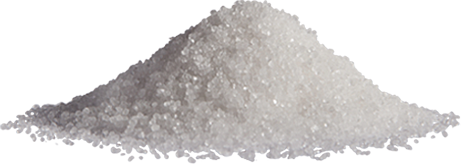CITRIC ACID
Overview:
Also referred to as sour salt or citric salt, citric acid is a naturally occurring, tart tasting, organic acid formed in citrus fruits. Citric acid is the crystalline material extracted from the juices of these fruits. Citric acid is used to add an acidic (sour) taste to foods and soft drinks and as a firming compound in products such as canned tomatoes.
At room temperature, most citric acids are a white, crystalline substance. Citric acid can exist either in an anhydrous (water-free) form or as a monohydrate (a compound that contains a single molecule of water). The monohydrate can be converted to the anhydrous form by heating above 172°F (78 °C). Because it occurs naturally, citric acid is usually classified as non-toxic and safe for food. It is naturally present in almost all forms of life, and excess citric acid is readily metabolized and eliminated from the body.1
Citric acid is a weak acid because of how it ionizes in water.2 While more expensive than most processed acids, citric acid is highly versatile with multiple applications. Biodegradable, citric acid is generally less harmful to the environment and therefore easier to dispose of after use than most processed acids.3
Characteristics and Challenges:
Most grades of citric acid have an average bulk density of 48lb/ft4. Citric acid may have an MSDS H rating as high as 2, meaning hazardous in case of eye contact (irritant), of inhalation (lung irritant) and slightly hazardous in case of skin contact (irritant, sensitizer).5
Typically crystalline in form, most citric acid may also be micronized. Citric acid is hygroscopic, meaning that humidity and temperature may impact its flow.
Citric acid can be both abrasive and corrosive, so care must be taken to use equipment that can withstand prolonged exposure to this material. Citric acid can damage gaskets and fabricated metal and non-metal components in bulk handling material equipment. Consultation with an experienced provider of citric acid handling equipment is recommended when deciding on the proper application.
Another challenge to the successful handling of citric acid from storage vessels to the processing system is the material's tendency to solidify and agglomerate. If the citric acid has been transported to the facility in bulk bags, it may have formed into a nearly unmovable solid mass that will require mechanical pressure to break it up, enabling bulk bag unloaders to discharge the citric acid through bag spouts.
Even if the bulk bag has been conditioned, the frames used to discharge the bags may still require additional accessories to reduce the need for operator intervention when emptying the citric acid from the bag. This includes features such as spring-loaded frames that will elongate and stretch the bags as they empty and lighten, making them rigid and removing any pockets of citric acid cornered in the bags. Bag activating devices are usually effective in agitating the citric acid, dislodging collections of citric acid, promoting a better flow. Some of these bag activating devices also serve as an airtight seal between the bulk bag and the receiving hopper.
If the citric acid is being added into the processing stream from smaller (>50 lb./22.76 kg.) bags, a bag-breaking station with a dust hood, filtration devices and a pneumatic pulse cleaner is the recommended solution to support the manual unloading of the material. If empty bag disposal is an issue, a dust-tight bag compacting system may be necessary.

The geometry of the feed hoppers is another important aspect in handling citric acid. To prevent errors in the charging of the conveyor, there may be a need to incorporate devices such as vibrators or mechanical agitators to promote flow. A hopper screen above the receiving vessel will help protect the operators if the citric acid is being dumped manually into a hopper that is equipped with agitating devices.
If the citric acid is being pneumatically conveyed into a processing system, the blower used to move citric acid through the air line must be sized to meet the demands of the system. Citric acid tends to absorb moisture from the air. If this issue causes excessive clumping, additional devices may be required to reduce the humidity levels or draw moisture from the citric acid prior to its entrance into the conveyor.
Due to citric acid's crystalline form and its free-flowing nature, a round screw design is commonly used for flexible screw conveying.
Should your citric acid application feature the loading of micronized citric acid into bulk bags, the use of vibratory densification decks to de-aerate the citric acid as it fills and load cells to ensure the desired weight, will greatly maximize the capacity of the bulk bags.
Flexicon Applications:
Consultation with a Flexicon specialist will help you decide if a flexible screw or pneumatic solution best fits your citric acid application.
Flexicon's expert design and engineering staff will weigh each parameter and recommend the best solution for you. Upon request, Flexicon's test lab will simulate your citric acid handling functions before the system is installed in your plant.
Flexicon's product line of advanced flow promotion conveyors, high flow hoppers, deaeration/densification decks and a host of other components and accessories are proven performers that promote flow while reducing degradation, dusting and/or the separation of blends comprised of disparate particles.
Related Articles on Cirtic Acid:
1 The Chemical Company Citric Acid
2 HyperPhysics Concepts Citric Acid
3 The Chemical Company Citric Acid
4 Source: Powder and Bulk. Com - Bulk Density Chart
5 Material Safety Data Sheet, Citric Acid
Sources: Where noted. All other information courtesy of Flexicon Corporation.